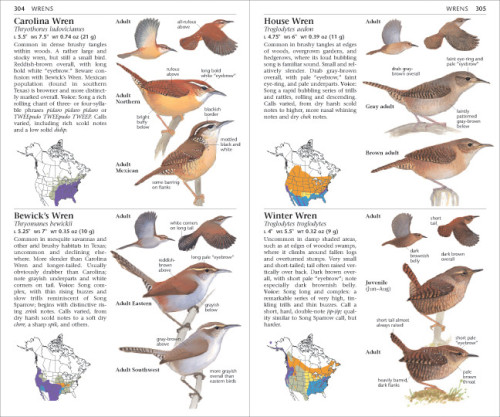
Sibley Field Guide to Birds of Eastern/Western North America
Alfred A. Knopf Publishers, New York, New York, 2003
Description
The bestselling Sibley Guide to Birds is the most comprehensive single-volume guide to the birds of the United States and Canada and is widely used by birding enthusiasts in the identification of bird species. The large size of the book (6 x 9.5 x 1.5 inches, weighing nearly 3 pounds), however, makes carrying it into the field difficult. And while the book’s 6,600 plus illustrations can be enjoyed by birders of any level of expertise, the condensed, telegraphic style of the text was written for those possessing moderate to advanced knowledge of the subject matter. The Sibley Field Guide to Birds of Eastern North America and The Sibley Field Guide to Birds of Western North America were created to provide the same superb visual information in a portable format (4.5 x 7.5 x 1.25 inches, weighing slightly more than one pound), with descriptive text that is easily interpreted by birders of all levels, from novice to advanced.
Birds in the original Sibley guide are presented in two vertical columns per page; species names, measurements, and very brief descriptive information are set at the top of each column, illustrations are placed below this text, and the voice description and range map are set at the bottom of the column. The smaller trim size of the new field guides rendered this vertical column presentation impossible: the narrower width did not allow illustrations to be placed side by side, and the shorter height did not provide space for the expanded descriptive text. A different two-column format solved both of these problems. As a rule, two species are set one atop the other on a page instead of next to each other. The names, measurements, text, and range map are set in a narrow column on the left and the illustrations are set in a wide column on the right. Because the width of the illustration column is identical to the column width in the original guide, illustrations can be placed side by side at the same size as they appear in the original.
The illustration columns are packed with information: illustrations, plumage labels and seasonal dates, callout text, and leader lines. Clean, consistent presentation of this information was crucial in making the books attractive and accessible. The three designers who created the initial layouts were given detailed instructions: illustrations and plumage labels should line up across the spread; callouts cannot exceed 36 points in width; leader lines must be set horizontally, vertically, or at 45 degrees and must measure 9, 12, 15, 18, 21, or 24 points; etc. While the rules had to be bent or broken occasionally in order to make the information fit, they helped to create an overall sense of order and consistency. To further this consistency, the designer of the books carefully and frequently reviewed the layouts, checking and adjusting each illustration, label, callout, and leader line, to give every spread in both books a uniform, polished appearance.
Since their publication in April 2003, The Sibley Field Guides have garnered much praise from the birding world and have sold well. (The western guide went into its second printing seven months after its introduction.) In April of 2004, Birdingmagazine described the guides as “an eminently usable, attractive, interesting, and worthwhile pair of new field guides birding.” It is anticipated that the guides will remain in print for many years, perhaps decades, to come.
Juror Notes
“A standard for the industry for a reason. An example of clarity in design and usefulness.” Archie Ferguson
Credits
- Design firm
- Alfred A. Knopf Publishers
- Art director
- Drew Stevens
- Designer
- Drew Stevens
- Jacket designer
- Drew Stevens
- Illustrator
- David Allen Sibley
- Production director
- Alicia Mills
- Production coordinator
- Arthur Riscen
- Author
- David Allen Sibley
- Editors
- Pamela Nelson, George Scott
- Publisher
- Alfred A. Knopf Publishers
- Trim size
- 4.5 x 7.5”
- Pages
- East 432/West 472
- Quantity printed
- East 188,000/West 110,000
- Compositor
- Chanticleer Press
- Typefaces
- Stone Sans, Stone Serif
- Printer
- Dai Nippon Printing Co.
- Jacket printer
- Dai Nippon Printing Co.
- Papers
- Mitsubishi, New V, white, 105 gsm, text, no finish
- Binder
- Dai Nippon Printing Co.
- Binding method
- Flexi-binding
- Book type
- Reference




